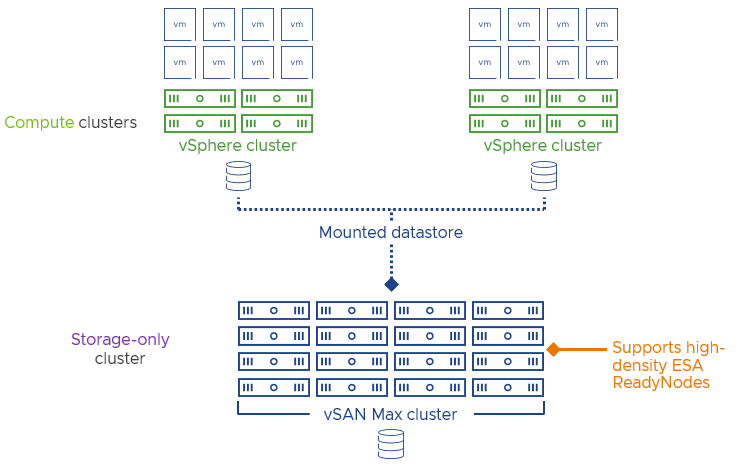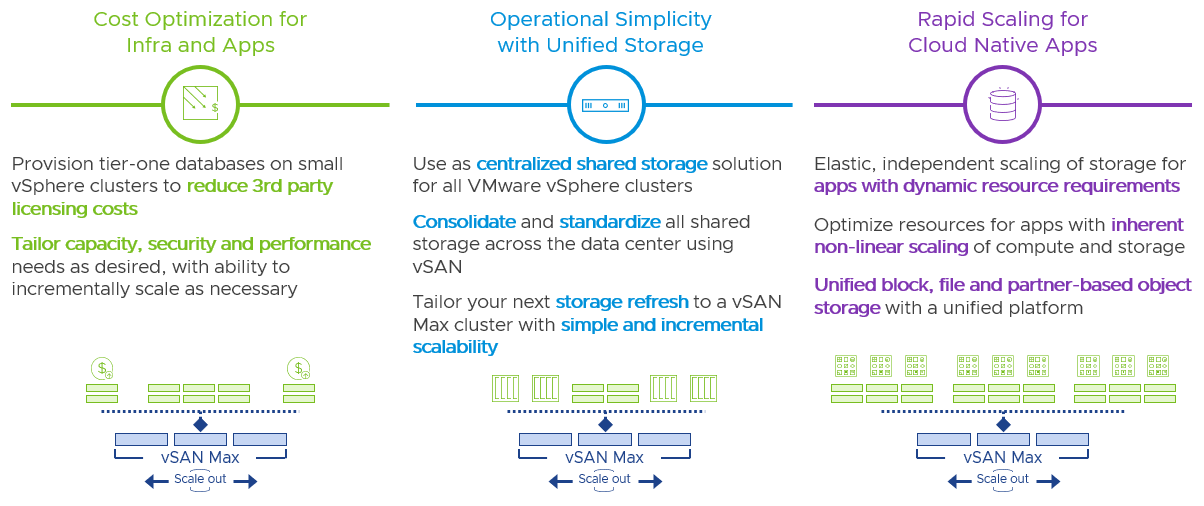Last week at VMware Explore a few vSAN features and offerings were announced, one of them being vSAN Max! All week I have been having conversations with customers who were highly excited about the new solution. For those who did not read the announcements, or listened to the Unexplored Territory Podcast episode on the topic, let me go over what was announced and what vSAN Max is.
As most of you know, vSAN is a hyperconverged storage platform delivered via VMware’s flagship product vSphere. This means that if you have vSphere running, vSAN is literally two clicks away from being enabled. You will need local storage devices, and those local devices then will be formed into a shared datastore on top of which you can run your VMs. Although HCI solutions work for most customers, at certain levels of scale it may be preferred to have a disaggregated solution and share a dedicated storage platform with one or multiple vSphere clusters. This is what vSAN Max brings to the table.

Looking at the above diagram a few things stand out when it comes to vSAN Max. First of all, it says “Storage Only” and secondly it mentions “Supports high-density ESA ReadyNodes”. There are a few things to unwrap here. Firstly, vSAN Max is based on vSAN Express Storage Architecture, aka vSAN ESA. This means that it is a single tier of storage, based on NVMe flash devices. On top of that, it also means that all available data services will also be available on vSAN Max: Fault Domains, Stretched Clustering, vSAN File Services, iSCSI, Compression, Encryption etc. All of these are also included by default in the license by the way, it is just a single edition from a licensing point of view and it will include vSphere. In other words, vSphere + vSAN Enterprise by default, and licensed on capacity instead of CPU/Cores.
Secondly, it mentions “high-density”, vSAN Max starts at 200TB per host, and has a minimum of 6 hosts per cluster. This means that the starting capacity is 1.2 Petabytes for a vSAN Max cluster. The maximum number of hosts within a cluster is 32 at the time of writing (but 24 hosts being the recommended maximum), and it will support up to 8.6 Petabytes and around 3.4 million IOPS.
It also mentions ReadyNodes, and let me stress this, ReadyNodes! We still see a lot of customers picking random components for their vSAN cluster and then being surprised that Skyline Health reports the cluster is not supported. For vSAN Max there will be a separate set of vSAN ReadyNode configurations. These configurations will have for instance 100Gbps network cards, and as mentioned a minimum of 200TB per host.
Now, this doesn’t mean that the connecting clusters need to be running 100GbE, they can be even 1Gbps connected, that’s up to you and the requirements you have from a performance perspective. The 100GbE connections will be used for intra-cluster communications, so the switching architecture also needs to cater to this.
Knowing all of this, you may wonder what the use cases are for vSAN Max. As Pete Koehler mentioned, it can be used for anything, but is primarily targeted at those with high capacity requirements and who prefer a centralized model, but still want to manage their storage platform through vCenter Server and use all the bells and whistles that come with it (and with VROps for instance).

Hopefully, that provides some insights in terms of what to expect when vSAN Max goes “general availability” I will follow up with some short demos showing what it will look like, although that will probably be relatively boring as it will look very similar to vSAN ESA. In the meanwhile, there’s a bunch of material on the VMware website that you can check out.
Great post and details. I am trying to wrap my mind around what the use case for this will be? So far I can think of a high end enterprise wanting a single mgmt interface for their storage. Any public facing documents around what problem this can solve for an enterprise?
Great post
So HCI is finishing the traditional array replacement by becoming an… array?
For environment at a specific scale and for customers who prefer to have things disaggregated indeed 🙂